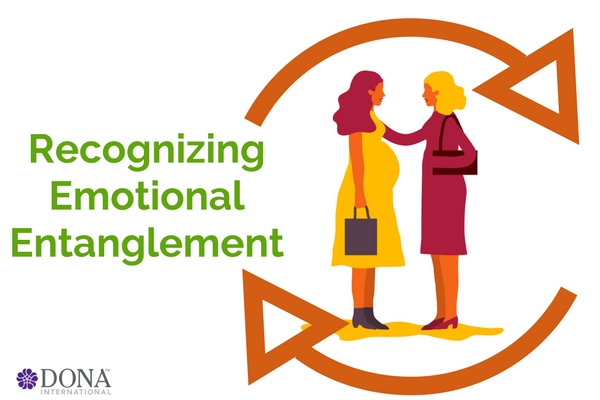By Kate Causbie
Ask any doula why they do the work they do, and odds are that their answer will somehow integrate or reflect their own experiences around conception, birth, and early parenting. While this is a valuable insight into the source of their motivation and passion, doulas as professionals are largely unsupported in how to process their own emotions and agendas before professionally supporting a client. In some ways, this work can then become more about the doula — and their desire: to be a helper, to heal, to save — than the client.
Support Professionals
Doulas are not therapists. Both professions have a very different scope, education, and paradigm. However, they both support the emotional processes of a client, typically without offering direct advice. While doulas know birth, pregnancy, and the beginning of parenthood inside and out, psychotherapy’s “process of understanding clients and their problems and developing solutions” (American Psychological Association) has a much older formalized support-person tradition, which lends valuable insight into addressing the psychological needs of the doula.
Psychotherapy acknowledges that when we are a support person to a client, our own feelings on the contents of their experience offer us both insight and complication. Transference and countertransference are two such ways that emotional entanglement often occurs. Many people talk about arriving at doula work out of their own emotional and passion-filled relationship to a conception and birth experience, and this should be a critical point of examination.
Transference & Countertransference
Transference refers to a process that happens with or without a person being aware of it, where they project onto their doula (or therapist, or other space-holder) the patterns and familiarity of other relationships and previous experiences. Perhaps a client chooses a doula who reminds them of their friend or family member, or they may choose to work with someone who represents their ideas of a relationship that they never had. In therapy, the therapist might work through this projection with the client in order to process any emotions around those other relationships, because it might interfere with the therapeutic work. This is less likely or problematic in the context of the work a doula does, and processing that dynamic is not within the scope of practice of a doula.
 Countertransference is the opposite, and applies more directly to the personal work doulas may need to do in general – because it carries across every client and throughout the duration of their entire career. Countertransference is the doula’s (or therapist’s) own emotions from an outside experience coming into the emotional space that the doula is providing the client, and affecting how they think about and respond to that person.
Countertransference is the opposite, and applies more directly to the personal work doulas may need to do in general – because it carries across every client and throughout the duration of their entire career. Countertransference is the doula’s (or therapist’s) own emotions from an outside experience coming into the emotional space that the doula is providing the client, and affecting how they think about and respond to that person.
To offer a dramatic and clear example, if a therapist suffered abuse as a child and finds themselves drawn to work with children who themselves are victims of abuse, they would need to do a lot of personal work before they could successfully support those children, without seeing themselves in each of them. Not only is that triggering, but it can become a way for the therapist to seek to more fully heal themselves through healing the children, which is not in the children’s best interest because the therapist is effectively unable to separate their own previous experience from that of the children. A more subtle example might be when a client brings up an interaction with their mother, the therapist should not be bringing their own needs around their relationship with their mother into the support they provide.
Countertransference could show up in similar ways for a doula. Perhaps someone is called to doula work because they or a loved one experienced a traumatic birth, and the doula is seeking healing for it by offering others the support they felt was lacking in their personal experience. That doula would need to do inner work to ensure that they are truly acting in the client’s best interest and not seeing themselves or their loved one in the client. Alternately, suppose a doula had a positive experience with breastfeeding their own children and then meets a client who is electing to not breastfeed at all. As a professional support person, the doula needs to be able to support that client without emotions from their personal experience becoming entangled.
The Key is Awareness
Therapists and counselors undergo a great deal of training and support to become aware of their own feelings that may become instances of countertransference. They learn to identify what might be bleeding into the support they are offering a client, and how to take care of their own feelings, separately, so that they are providing support catered directly to the client. If the support person is not aware of countertransference occurring then there is a great deal of potential for harm to both the client and therapist.
Similar to therapists, doulas’ work requires that they are aware of when a particular situation with a client crosses over into their own emotional process, and understand in what ways a client’s emotions overlap with their own. If they have any trauma, agenda, or “fire” lit in them around the client’s experience, they must proceed with utmost caution and take the steps to undergo their own processing outside the client-doula relationship. Furthermore, the doula should have the ability to see the client’s experience as uniquely their own and are able to control the desire to offer insight based on personal experience. It takes a lot of learning to parse through our own experience. This is an important conversation to be having in doula trainings.
Psychology has known this for ages: that awareness, caution, and control with these matters is key. A doula must be able to distinguish their client’s feelings from their own.
Moving Towards Supporting Doulas
What would it look like for a doula’s psychological needs to be formally supported in this way, so he or she can more fully step into an effective support role? How can we better prepare doulas to be support people with utmost awareness for the line between their own experience and emotions, and a client’s? What outside situations, experiences, and emotions entangled with your support of clients? What have you found to be helpful for processing your own emotions?
References
American Psychological Association. “Different approaches to psychotherapy.” http://www.apa.org/topics/therapy/psychotherapy-approaches.aspx
About Kate Causbie
 Kate Causbie is a birth doula from Seattle, Washington. She holds a BA in Critical Social Psychology from Wittenberg University. Kate can be reached at www.katecausbie.com.
Kate Causbie is a birth doula from Seattle, Washington. She holds a BA in Critical Social Psychology from Wittenberg University. Kate can be reached at www.katecausbie.com.



Thank you for your thoughtful explanation of this. I have known of its existence but did not know the word for it. “Countertransference” and the concept of “secondary traumatization” are 2 labels that I have learned this year that have helped me more clearly understand experiences that doulas may have.
Thank you so much for this post. I hope these ideas will become part of every doula training.
This was a great article. Thank you for so clearly, non-judgementally articulating this so we can learn and serve our clients better.
Thank you for this very important, clear and concise article.
Thank you, Kate, for your insight and clear explanation of some of the challenges that doulas face in their deeply personal and complex relationships with their clients who are experiencing a life-changing transition. The questions at the end of your article are thought-provoking and challenging. You’ve got me thinking! Thank you,